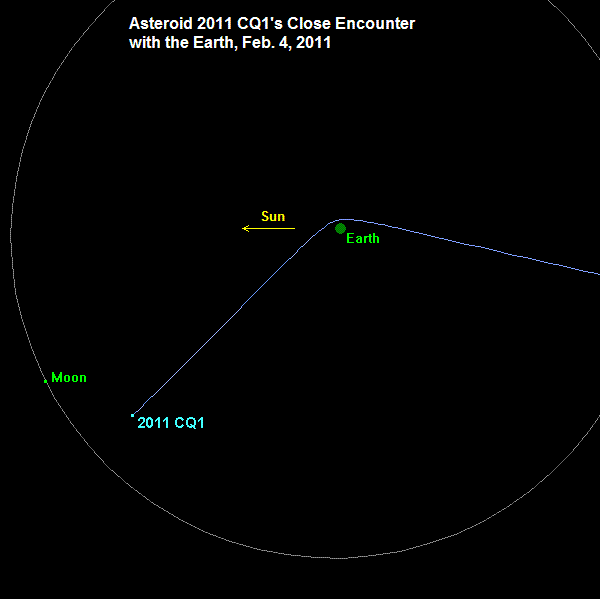Emily Lakdawalla • Feb 08, 2011
Close approach to Earth turns Apollo into Aten
Last week we got buzzed by a very small asteroid, something that happens fairly often (in fact, there's another tiny close approacher incoming now). But there were several details that made the close approach of asteroid 2011 CQ1 worthy of note. These were summarized in a web update by the ever-informative Don Yeomans and Paul Chodas of JPL's Near-Earth Object Program Office.
2011 CQ1 was discovered (as are lots of near-Earth asteroids) by the Catalina Sky Survey; their three facilities contribute to discovering new objects at a rate of about four or five per week, on average. It was first observed on February 4 at 04:00 UT and found to have a trajectory that would take it to a perigee of about 12,000 kilometers. Now, while "perigee" means "closest approach to Earth," you are probably not thinking the same thing that an astronomer is thinking. You're probably thinking about the distance between the Earth and the approaching object -- its altitude. But an astronomer measures inter-body distances with respect to the centers of the bodies. Most of the time, objects in space are so far away from each other that it doesn't really matter whether you're measuring with respect to object surfaces or centers. But 12,000 kilometers is less than one Earth diameter, so in this case it matters a lot; the close approach was predicted to be at 12,000 kilometers minus (12,756/2 or half Earth's diameter), or only about 5,000 kilometers altitude. Which is still a safe distance from Earth, and above low-Earth orbit, but well within the orbits of lots of artificial satellites.
Even if 2011 CQ11 was on a collision course, it wouldn't really have mattered; its faintness indicates that it is small, maybe a meter or two across. As Yeomans and Chodas wrote, "Because of their small size, objects of this size are difficult to discover but there is likely to be nearly a billion objects of this size and larger in near-Earth space," and such objects very likely hit Earth about once a week. "Upon striking the atmosphere, small objects of this size create visually impressive fireball events but only rarely do even a few small fragments reach the ground."
2011 CQ1 didn't hit Earth, which makes what happened to it more interesting. Consider the trajectory diagram that was posted on the JPL website:

You can readily see that 2011 CQ1 got an impressive gravity assist from Earth that bent its course through space by 60 degrees. The asteroid's orbit has changed so much that it's gotten reclassified, as Yeomans and Chodas explained: "This object, only about one meter in diameter, is the closest non-impacting object in our asteroid catalog to date. Prior to the Earth close approach, this object was in a so-called Apollo-class orbit that was mostly outside the Earth's orbit. Following the close approach, the Earth's gravitational attraction modified the object's orbit to an Aten-class orbit where the asteroid spends almost all of its time inside the Earth's orbit."
The encounter illustrates how the big planets can dramatically change the orbits of the smaller bodies that cross their paths, stirring and mixing space rocks throughout the solar system, changing the distribution of different types of materials. Little 2011 CQ1 was most likely an ancient little rock, unchanged for more than 4 billion years; a chance encounter with some larger body may have set it up for a gravitational assist from yet another body that caused its path to cross Earth's, and now it's going to spend its the rest of its existence much closer to the Sun than it has ever been in the past. And now that we've had this one encounter with it, we're unlikely ever to see it again; since it's so tiny and so faint, with such a short observational arc, we'll probably never be close enough to it again to be able to pick its dim light out from the background of stars.
The Time is Now.
As a Planetary Defender, you’re part of our mission to decrease the risk of Earth being hit by an asteroid or comet.
Donate Today

 Explore Worlds
Explore Worlds Find Life
Find Life Defend Earth
Defend Earth

